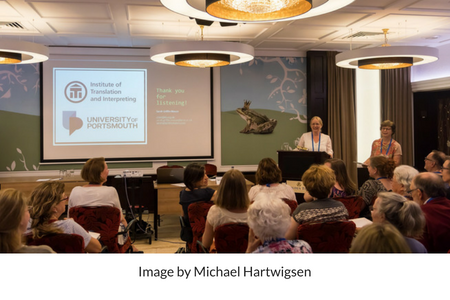 A call to arms
A call to arms
Sarah Griffin-Mason gave an illuminating plenary talk at the SENSE 2018 conference: 'Trends in translating and interpreting to 2050.’ Claire Bacon caught up with her a few days after the conference to find out more.
We are experiencing an onslaught of rapid technological development. The rise in automation translation technologies may have left you wondering how we can survive in this ever-changing world. ‘We have to adapt’, Griffin-Mason told us.
In her plenary talk, Griffin-Mason, Chair of the UK’s Institute of Translation and Interpreting, discussed how improvements in machine translation may affect language professionals in the future and how we can push back. Her message was based on information gleaned from the International Federation of Translators meeting in August 2017, where a number of leading issues affecting language professionals were discussed. So what are the threats and what are our options?
Rise of the machines
Artificial intelligence is a leading concern for language professionals. But could we really be replaced by machines in the future?
Futurist Ray Kurzweil seems to think so. In his book The Singularity is Near, Kurzweil talks about how an exponential increase in technologies will eventually culminate in the Singularity – a point when technology will merge with human intelligence. Once the Singularity has been reached, machine intelligence will master human intelligence and effectively take over.
So where does that leave us? It is hard to imagine that the ambiguity and flexibility of human language can be accurately translated by a machine with no understanding of the world.
Lucky for us, computer language translation will be one of the last technological applications to compete with humans. In his book, Kurzweil acknowledges that dealing with language is the most challenging task for artificial intelligence because it cannot understand the context of words or how a text works. Despite this, he predicts that machine translation will be good enough to replace many human translators by 2029.
Machine learning
New approaches to automated translation are bridging the gap between human and machine translation. Neural machine translation uses artificial neural networks that mimic the human brain to predict word sequences and generate sentences. But is this new approach really as good as human translation?
Microsoft researchers recently claimed to have created a machine translation system that achieved human parity when translating certain segments of a Chinese news bulletin into English. Human parity was assessed by bilinguals (not translators) who compared a set of machine translations with the corresponding human translations. No statistically significant differences were observed between the human translations and machine translations.
But before we hand our jobs over to the machines, it is important to note that this result was restricted to a specific set of translations. It is still not clear whether machine translation systems can translate any text in any language pair as well as a professional human translator.
Machines need people
‘The key issue’, says Griffin-Mason, ‘is that human processing and use of language are not the same as machine processing and use of language. Furthermore, machines need people – automated translation systems will need to be tested and refined by language experts.’
In an article for The Economist, Robert Lane Greene has argued that machine translation will always need to be quality controlled by humans because, no matter how sophisticated a computer is, it will never be able to truly understand the meaning of a text. Editing is already an important part of what translators do and, Greene says, may become far more important as artificial intelligence and machine translation improve and expand.
‘The surviving paid roles in the future’, says Griffin-Mason, ‘will be those that require soft skills and quality control that are beyond the scope of what machines can do’.
A call to arms
The challenges we face as language professionals are real. If we do not guard against them, the exponential advances in technology will weaken translation and editing expertise, combining with the gig economy model in a way that will be even more challenging for future generations. Griffin-Mason issued a call to arms on behalf of translators everywhere: to defend our profession.
First and foremost, we need to start raising the profile of translation as a professional service that is essential to our clients – and we need to emphasize what we can do that machines cannot.
‘Good translation is so much more than knowing a language’, Griffin-Mason says, ‘it requires specialist knowledge of the subject being translated, the purpose of the document being translated and cultural sensitivities’. Machines do not possess this knowledge and understanding.
We can propagate the message that human translation is important by joining a professional entity and getting involved in conversations. Write articles, join in debates on social media, give speeches. It is our job to defend our profession; nobody is going to do it for us.
Griffin-Mason’s message is very clear: we must not quit. What we do need to do is to prepare for and adapt to the forthcoming challenges. Whatever it takes.
Want to know more? Read The Singularity is Near by Ray Kurzweil to understand the full force of what could be possible. If this motivates you to take a stand, then read WTF?: What’s the Future and Why It’s Up to Us by Tim O’Reilly to learn how to get in on the conversation and help shape our future.